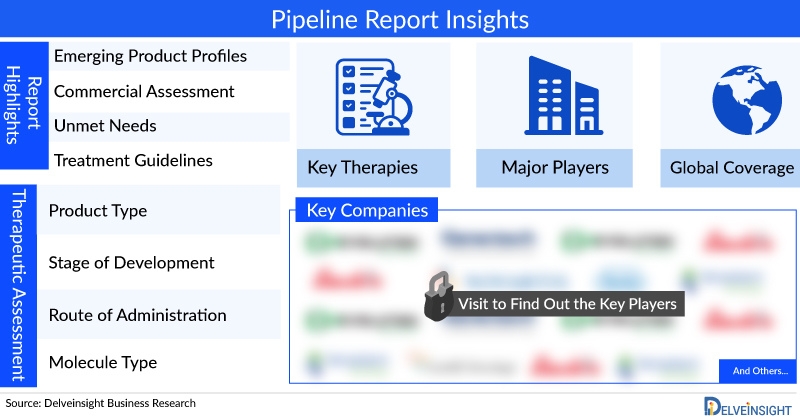DelveInsight’s “Sturge-Weber Syndrome – Pipeline Insight, 2025” spotlights emerging candidates aimed at modulating abnormal vascular signaling, reducing neurological complications, and preventing long-term sequelae. Novel small molecules and biologics targeting angiogenesis pathways (such as VEGF and MAPK signaling), advanced anti-epileptic formulations with improved CNS penetration, and neuroprotective agents are in various stages of development. Additionally, experimental approaches involving gene therapy, RNA-based modulation, and regenerative strategies are being explored to correct or bypass pathogenic GNAQ mutations driving the condition.
The 2025 pipeline underscores a shift from purely symptomatic treatment toward mechanism-driven, disease-modifying interventions. With advancements in molecular diagnostics, early detection, and precision medicine, combined with orphan drug incentives and collaborative rare disease research networks, the coming years could see breakthroughs that change the trajectory of SWS—from lifelong symptom management to targeted, potentially curative therapies.
Interested in learning more about the current treatment landscape and the key drivers shaping the Sturge-Weber Syndrome pipeline? Click here
Key Takeaways from the Sturge-Weber Syndrome Pipeline Report
• DelveInsight’s Sturge-Weber Syndrome pipeline analysis depicts a strong space with 4+ active players working to develop 4+ pipeline drugs for Sturge-Weber Syndrome treatment.
• The leading Sturge-Weber Syndrome companies include Pfizer, Qlaris Bio, Inc., GW Pharmaceuticals, IDEAYA Biosciences, and others are evaluating their lead assets to improve the Sturge-Weber Syndrome treatment landscape.
• Key Sturge-Weber Syndrome pipeline therapies in various stages of development include Sirolimus, QLS-101, Cannabidiol, Darovasertib, and others.
• In August 2025, the Kennedy Krieger Institute reported its sirolimus trial for cognitive impairment in SWS had completed recruitment with data analysis underway and planning for a second phase.
• In March 2025, a preprint reported MAPK pathway activation and ANGPT2 involvement in SWS vascular pathology, reinforcing the rationale for targeted therapies (e.g., MEK inhibitors).
• In December 2024, a comprehensive Frontiers review highlighted pilot clinical trials in SWS—including cannabidiol (Epidiolex) and sirolimus—showing early signals in seizure control and cognition, and motivating next-phase studies.
Sturge-Weber Syndrome Overview
Sturge-Weber Syndrome (SWS) is a rare congenital neurological disorder classified under phakomatoses or neurocutaneous syndromes. It is caused by a somatic mutation in the GNAQ gene and is typically not inherited. The hallmark features of SWS include a facial port-wine stain (usually affecting the forehead and upper eyelid on one side), leptomeningeal angiomas (abnormal blood vessel growths on the brain’s surface), and ocular abnormalities such as glaucoma. Neurological symptoms often include seizures, which may begin in infancy, stroke-like episodes, developmental delays, and muscle weakness or paralysis on one side of the body. The severity and progression of symptoms can vary widely among individuals.
There is currently no cure for Sturge-Weber Syndrome, and treatment is focused on symptom management. This includes anticonvulsant medications to control seizures, laser therapy to lighten or remove port-wine stains, and medications or surgery to manage glaucoma. Regular monitoring through imaging (e.g., MRI) and eye exams is essential for early detection of complications. Multidisciplinary care involving neurologists, dermatologists, ophthalmologists, and developmental specialists is often required to address the range of symptoms and improve quality of life. Ongoing research into genetic and targeted therapies holds promise for more effective future treatments.
Find out more about Sturge-Weber Syndrome medication at https://www.delveinsight.com/report-store/sturge-weber-syndrome-pipeline-insight
Sturge-Weber Syndrome Treatment Analysis: Drug Profile
Sirolimus: Pfizer
Sirolimus, also known as rapamycin, is a macrolide compound primarily used for coating coronary stents, preventing organ transplant rejection, and treating the rare lung condition lymphangioleiomyomatosis. It functions as an immunosuppressant by inhibiting the mTOR pathway, which reduces the activation and proliferation of T and B cells through decreased sensitivity to interleukin-2 (IL-2). Sirolimus is particularly effective in preventing kidney transplant rejection. A Phase II/III clinical trial evaluating its efficacy has been completed.
Learn more about the novel and emerging Sturge-Weber Syndrome pipeline therapies.
Sturge-Weber Syndrome Therapeutics Assessment
By Product Type
• Mono
• Combination
• Mono/Combination.
By Stage
• Late-stage products (Phase III)
• Mid-stage products (Phase II)
• Early-stage product (Phase I) along with the details of
• Pre-clinical and Discovery stage candidates
• Discontinued & Inactive candidates
By Route of Administration
• Oral
• Parenteral
• Intravenous
• Subcutaneous
• Topical
By Molecule Type
• Monoclonal Antibody
• Peptides
• Polymer
• Small molecule
• Gene therapy
Scope of the Sturge-Weber Syndrome Pipeline Report
• Coverage: Global
• Key Sturge-Weber Syndrome Companies: Pfizer, Qlaris Bio, Inc., GW Pharmaceuticals, IDEAYA Biosciences, and others.
• Key Sturge-Weber Syndrome Pipeline Therapies: Sirolimus, QLS-101, Cannabidiol, Darovasertib, and others.
Explore detailed insights on drugs used in the treatment of Sturge-Weber Syndrome here.
Table of Contents
1. Introduction
2. Executive Summary
3. Sturge-Weber Syndrome Pipeline: Overview
4. Analytical Perspective In-depth Commercial Assessment
5. Sturge-Weber Syndrome Pipeline Therapeutics
6. Sturge-Weber Syndrome Pipeline: Late-Stage Products (Phase III)
7. Sturge-Weber Syndrome Pipeline: Mid-Stage Products (Phase II)
8. Sturge-Weber Syndrome Pipeline: Early Stage Products (Phase I)
9. Therapeutic Assessment
10. Inactive Products
11. Company-University Collaborations (Licensing/Partnering) Analysis
12. Key Companies
13. Key Products
14. Unmet Needs
15. Market Drivers and Barriers
16. Future Perspectives and Conclusion
17. Analyst Views
18. Appendix
About DelveInsight
DelveInsight is a leading Business Consultant and Market Research firm focused exclusively on life sciences. It supports Pharma companies by providing comprehensive end-to-end solutions to improve their performance. Get hassle-free access to all the healthcare and pharma market research reports through our subscription-based platform, PharmDelve.
Media Contact
Company Name: DelveInsight
Contact Person: Jatin Vimal
Email: Send Email
Phone: +14699457679
Address:304 S. Jones Blvd #2432
City: Las Vegas
State: Nevada
Country: United States
Website: https://www.delveinsight.com/

